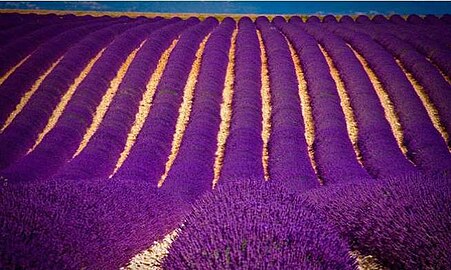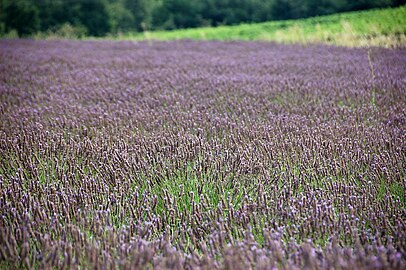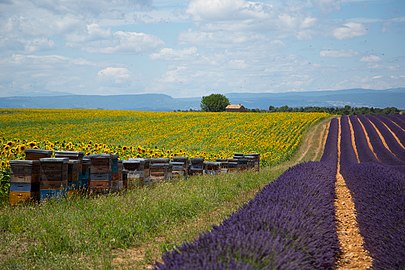Lavandula — разлика између измена
. |
(нема разлике)
|
Верзија на датум 4. април 2019. у 05:48
| Lavender | |
|---|---|
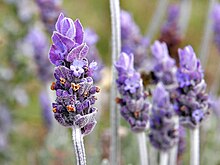
| |
| Cvet lavendera | |
| Naučna klasifikacija | |
| Carstvo: | Plantae |
| Kladus: | Tracheophytes |
| Kladus: | Angiospermae |
| Kladus: | Eudicotidae |
| Kladus: | Asterids |
| Red: | Lamiales |
| Porodica: | Lamiaceae |
| Potporodica: | Nepetoideae |
| Pleme: | Ocimeae |
| Rod: | Lavandula L. |
| Tipska vrsta | |
| Lavandula spica | |
| Sinonimi[1] | |
| |
Један корисник управо ради на овом чланку. Молимо остале кориснике да му допусте да заврши са радом. Ако имате коментаре и питања у вези са чланком, користите страницу за разговор.
Хвала на стрпљењу. Када радови буду завршени, овај шаблон ће бити уклоњен. Напомене
|
Lavandula (uobičajeno ime lavender) rod je sa 47 poznatih vrsta flowering plants in the mint family, Lamiaceae. It is native to the Old World and is found from Cape Verde and the Canary Islands, Europe across to northern and eastern Africa, the Mediterranean, southwest Asia, China (Plectranthus mona lavender) to southeast India.[2] Many members of the genus are cultivated extensively in temperate climates as ornamental plants for garden and landscape use, for use as culinary herbs, and also commercially for the extraction of essential oils.[3] The most widely cultivated species, Lavandula angustifolia, is often referred to as lavender, and there is a color named for the shade of the flowers of this species.
Opis
The genus includes annual or short-lived herbaceous perennial plants, and shrub-like perennials, subshrubs or small shrubs.[4]
Leaf shape is diverse across the genus. They are simple in some commonly cultivated species; in other species they are pinnately toothed, or pinnate, sometimes multiple pinnate and dissected. In most species the leaves are covered in fine hairs or indumentum, which normally contain the essential oils.[4]
Flowers are borne in whorls, held on spikes rising above the foliage, the spikes being branched in some species. Some species produce coloured bracts at the apices. The flowers may be blue, violet or lilac in the wild species, occasionally blackish purple or yellowish. The calyx is tubular. The corolla is also tubular, usually with five lobes (the upper lip often cleft, and the lower lip has two clefts).[4][5]
Lavenderovo ulje
Commercially, the plant is grown mainly for the production of essential oil of lavender. This has antiseptic[6][7] and anti-inflammatory[8] properties, and can be used as a natural mosquito repellent.[9] These extracts are also used as fragrances for bath products.
English lavender (Lavandula angustifolia) yields an essential oil with sweet overtones, and can be used in balms, salves, perfumes, cosmetics, and topical applications. Lavandula × intermedia, also known as lavandin or Dutch lavender, yields a similar essential oil, but with higher levels of terpenes including camphor, which add a sharper overtone to the fragrance.
The lavandins Lavandula × intermedia are a class of hybrids of L. angustifolia and L. latifolia.[10] The lavandins are widely cultivated for commercial use, since their flowers tend to be bigger than those of English lavender and the plants tend to be easier to harvest, but lavandin oil is regarded by some to be of a lower quality than that of English lavender, with a perfume less sweet.[11]
Istraživanja

Major constituents of lavender oil include linalool (26%) caryophyllene (8%).[12] The essential oil was used in hospitals during World War I.[13]
Lavender oil is under preliminary research for its possible effect in alleviating anxiety and sleep disturbances.[14] High-quality clinical research generally has not been done to conclude if there are effects of lavender oil on anxiety.[15]
Herbalizam
The German scientific committee on traditional medicine, Commission E, reported uses of lavender flower in practices of herbalism, including its use for restlessness or insomnia, Roehmheld's syndrome, intestinal discomfort, and cardiovascular diseases, among others.[16]
Zdravstvene mere
The U.S. National Institutes of Health (NIH) states that lavender is considered likely safe in food amounts and possibly safe in medicinal amounts. NIH does not recommend the use of lavender while pregnant or breast-feeding because of lack of knowledge of its effects. It recommends caution if young boys use lavender oil because of possible hormonal effects leading to gynecomastia[17][18], and states that lavender may cause skin irritation and could be poisonous if consumed by mouth.[19]
A 2005 review on lavender essential oil stated that "Lavender is traditionally regarded as a 'safe' oil and, although it was recently reported that lavender oil, and its major constituent linalyl acetate, are toxic to human skin cells in vitro, contact dermatitis to lavender oil appears to occur at only a very low frequency."[20] There are two reports on a total of six cases of gynecomastia in prepubertal boys who were exposed to topical lavender essential oil.[21][22]
A 2007 study examined the relationship between various fragrances and photosensitivity, stating that lavender is known "to elicit cutaneous photo-toxic reactions", but does not induce photohaemolysis.[23]
Taksonomska tabela

This is based on the classification of Upson and Andrews, 2004.
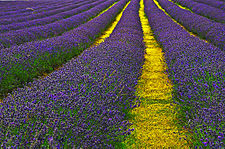

|
I. Subgenus Lavendula Upson & S.Andrews subgen. nov.
II. Subgenus Fabricia (Adams.) Upson & S. Andrews, comb.nov.
III. Subgenus Sabaudia (Buscal. & Muschl.) Upson & S. Andrews, comb. et stat. nov.
|
Galerija
-
Lavender flower
-
Flower of cultivated lavender; Lavandula stoechas
-
Lavender garden, India
-
A field of lavender in France
-
A field of lavender on the edge of the London Borough of Sutton, England
-
Lavender and honeybees outside Aix-en-Provence, France
-
lavandula
Reference
- ^ „World Checklist of Selected Plant Families: Royal Botanic Gardens, Kew”. kew.org.
- ^ „Outdoor flowering plants - mona lavender”. www.hgtv.com. HGTV. Приступљено 19. 10. 2018.
- ^ „Plant finder - Plectranthus mona lavender”. www.missouribotanicalgarden.org. Missouri botanical garden. Приступљено 19. 10. 2018.
- ^ а б в Upson T, Andrews S (2004). The Genus Lavandula. Royal Botanic Gardens, Kew 2004. ISBN 9780881926422. Приступљено 2012-03-30.
- ^ L. H. Bailey. Manual of Cultivated Plants. MacMillan Publishing Company.
- ^ Moon, T; Wilkinson, JM; Cavanagh, HM (2006). „Antiparasitic activity of two Lavandula essential oils against Giardia duodenalis, Trichomonas vaginalis and Hexamita inflata”. Parasitology Research. 99 (6): 722—8. PMID 16741725. doi:10.1007/s00436-006-0234-8.
- ^ Inouye, S.; Takizawa, T.; Yamaguchi, H. (2001). „Antibacterial activity of essential oils and their major constituents against respiratory tract pathogens by gaseous contact”. Journal of Antimicrobial Chemotherapy. 47 (5): 565—73. PMID 11328766. doi:10.1093/jac/47.5.565.
- ^ Hajhashemi, V; Ghannadi, A; Sharif, B (2003). „Anti-inflammatory and analgesic properties of the leaf extracts and essential oil of Lavandula angustifolia Mill”. Journal of Ethnopharmacology. 89 (1): 67—71. PMID 14522434. doi:10.1016/S0378-8741(03)00234-4.
- ^ Natural Mosquito Repellents in the Wild
- ^ Mark Griffiths, Index of Garden Plants (Portland, Oregon: Timber Press, 1994. ISBN 0-333-59149-6.)
- ^ National Non-Food Crops Centre. "Lavender". Retrieved on 2009-04-23.
- ^ Umezu, Toyoshi; Nagano, Kimiyo; Ito, Hiroyasu; Kosakai, Kiyomi; Sakaniwa, Misao; Morita, Masatoshi (1. 12. 2006). „Anticonflict effects of lavender oil and identification of its active constituents”. Pharmacology Biochemistry and Behavior. 85 (4): 713—721. PMID 17173962. doi:10.1016/j.pbb.2006.10.026. Приступљено 20. 2. 2017.
- ^ Grieve, Mrs. M. A Modern Herbal, Vol. II, New York: Dover Publications, Inc., 1971. ISBN 0-486-22799-5)
- ^ Kasper, S; Gastpar, M; Müller, WE; Volz, HP; Möller, HJ; Dienel, A; Schläfke, S (2010). „Silexan, an orally administered Lavandula oil preparation, is effective in the treatment of 'subsyndromal' anxiety disorder: a randomized, double-blind, placebo controlled trial”. International Clinical Psychopharmacology. 25 (5): 277—87. PMID 20512042. doi:10.1097/YIC.0b013e32833b3242.
- ^ Perry, R; Terry, R; Watson, L. K.; Ernst, E (2012). „Is lavender an anxiolytic drug? A systematic review of randomised clinical trials”. Phytomedicine. 19 (8–9): 825—35. PMID 22464012. doi:10.1016/j.phymed.2012.02.013.
- ^ „Expanded Commission E monograph: Lavender flower”. cms.herbalgram.org. Integrative Medicine Communications, Germany; from the American Botanical Council. 2000. Приступљено 18. 10. 2018.
- ^ „Oils 'make male breasts develop'”. British Broadcasting Corporation. фебруар 2007. Приступљено 2018-03-17.
- ^ „More evidence essential oils 'make male breasts develop'”. British Broadcasting Corporation. март 2018. Приступљено 2018-03-17.
- ^ „Lavender: Science and Safety”. National Center for Complementary and Integrative Health. март 2007. Приступљено 2013-11-05.
- ^ Cavanagh, Heather MA; Wilkinson, Jenny M (март 2005). „Lavender essential oil: a review” (PDF). Australian Infection Control. CSIRO Publishing. Приступљено 2013-11-06.
- ^ Henley DV, Lipson N, Korach KS, Bloch CA (2007). „Prepubertal gynecomastia linked to lavender and tea tree oils”. N. Engl. J. Med. 356 (5): 479—485. PMID 17267908. doi:10.1056/NEJMoa064725.
- ^ Diaz A, Luque L, Badar Z, Kornic S, Danon M (2016). „Prepubertal gynecomastia and chronic lavender exposure: report of three cases”. J. Pediatr. Endocrinol. Metab. 29 (1): 103—107. PMID 26353172. doi:10.1515/jpem-2015-0248.
- ^ Placzek, M; Frömel, W; Eberlein, B; Gilbertz, KP; Przybilla, B (2007). „Evaluation of phototoxic properties of fragrances.”. Acta Dermato-venereologica. 87 (4): 312—6. PMID 17598033. doi:10.2340/00015555-0251.



